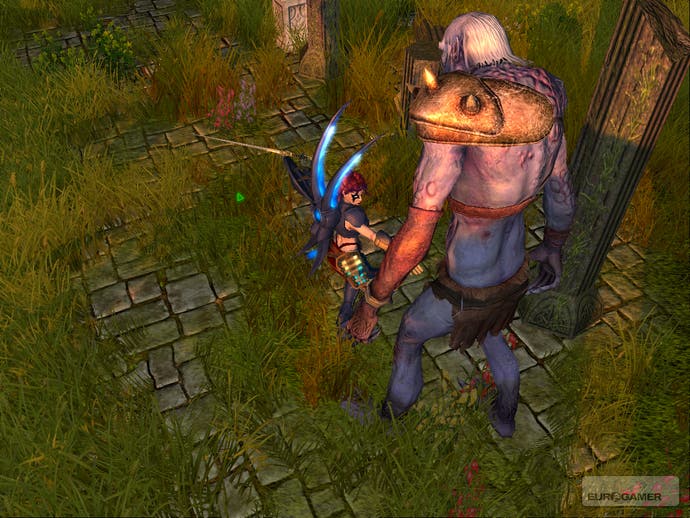Sacred 2: Fallen Angel
Oh come all ye faithful.
Angelic Horde
Graphically, the whole game looks gorgeous even at this early stage. Unlike many other hack and slash games, Sacred II eschews the gritty, dark look common in the fantasy genre, preferring a vibrant, bright look with a colourful palette. This is most obvious on the surface of the world, but even the dungeons are a bit more colourful and rich than you might expect from a game of this sort. It's a conscious decision on the part of the developers which sets the art style apart from much of the rest of the western RPG market, which seems obsessed with setting its adventures in a sort of brutalist, ill-conceived seventies housing development in medieval East London.
And, of course, it's Next Gen; which at the moment means self-shadowing for more realistic lighting, convincingly detailed foliage, loads of enemies on-screen at once (a rather crucial point for Sacred II's gameplay, we might add, so it's just as well it seems to work well) and ragdoll physics to provide moments of occasional macabre hilarity. Everything you'd expect from Xbox 360 graphics reports present and correct, along with some nice attention to detail in the artwork and lighting. There's even a fully implemented day-night cycle, with shadows lengthening and moving around appropriately throughout the day, the sky reddening at dawn and dusk, and so on.
Gameplay, of course, is always more difficult to assess from a demonstration - especially a demonstration of code which might most charitably be described as a bit early. What we can report, however, is that the storyline is a prequel to the plot of the original Sacred - in fact, it's set 2000 years beforehand, and revolves around a conflict between the ruling High Elves and the seemingly unpleasant Inquisitors over a magical resource called "T-energy".

Once again, there are six characters to choose from - with only one of those, the Seraphim, making a return from the original game (due, the developers say, to the immense popularity of the character). The battle between the Elves and the Inquisitors isn't quite as simple as a conflict between good and evil, and consequently the two very different campaigns in the game are known as "light" and "shadow"; Inquisitor characters may only play Shadow, Seraphim characters may only play Light, but others can choose to follow whichever path they like.
Of the new classes we saw, the one that really caught our eye was the Shadow Warrior - a high ranking human warrior in the High Elf army, who died and was brought back to life by the elves' magic, and is now cursed to walk the earth for eternity. Aside from the fact that he's essentially a zombie, and thus automatically awesome, his various armour sets are convincingly dark and nasty looking (although he's not necessarily an evil character, and can play the Light campaign if you want), and he boasts an impressive range of physical and magical skills.
Holy Flame

Which, conveniently, brings us onto two topics; firstly, armour. A lot of work has gone into the armour sets in Sacred II, which are unique to each character and very, very impressive looking - with dramatic designs for later armour sets which easily stack up against the best armour in most MMOG titles. Kitting out your character in the best possible duds looks like being a major incentive in this game, although we're not sure what the multiplayer opportunities for showing off your shiny new gear will be like.
Secondly, skills. Like the original Sacred, this sequel describes its various skills as Combat Arts, and you equip them to an action bar as you'd expect. They're divided into three aspects for each character class, and as you progress you can choose whether you wish to specialise in one aspect, or spread your skill points out more generally over all three to create a balanced character.
So far, so normal; but Sacred II also promises a level of customisation of individual skills which is rarely found in games of this type. Each time you upgrade a skill, you'll be presented with a number of different options for what kind of upgrade you want to apply, rather than simply following a linear path. For example, when taking a Fireball spell up a level, you might have to choose between simply levelling up the same spell, giving a more potent fireball; or turning it into a multi-shot fireball; or perhaps making it into a homing fireball.
The choices you make will fundamentally change the strengths and weaknesses of your character, which could arguably be seen as Sacred II's compensation for pre-rolling the six playable characters in the game rather than giving the player massive freedom at the outset. Ascaraon claims that this means that once you get into the game, any two Shadow Warriors (for example) could be completely different from one another, despite being the same class.

The hack 'n slash genre has been ticking along fairly quietly for the last few years, rarely throwing up anything that really appeals to gamers who aren't already ensconced in the genre - but Ascaron seems quite determined to change that with Sacred II. Attention to detail and accessibility are key phrases which popped up a lot during our viewing of the game, and the decision to bring it to the Xbox 360 (which isn't exactly a platform with an embarrassment of riches in this genre, despite the success of games like Baldur's Gate: Dark Alliance on consoles in the past) is a clear statement of intent. It certainly looks good; we'll be looking forward to reporting back on how it plays in due course.
